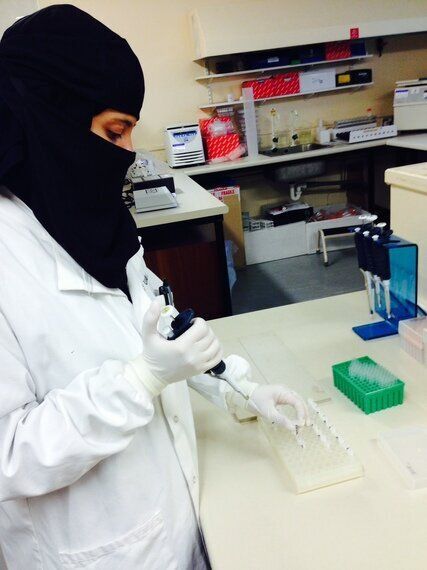
Image: Author's own'
Thousands of women joined World Hijab Day on 1st of Feb, a day that aims to raise awareness about wearing the Hijab and celebrates women's right to choose what they wish to wear. Indeed, such awareness is much needed in many democratic societies, where there is a significant rise of Islamophobia.
Muslim women, who choose to wear the face-veil (Niqab), out of conviction of faith, also joined World Hijab Day, as they too wish to assert their desire to wear it for similar reasons and purposes as the Hijab. Although there are no statistics on the number of Muslim women who choose to wear the Niqab, they are certainly a minority within a minority. Nevertheless, some politicians disproportionately focus on the Niqab as a polarising tool, using it to instill fear and divide communities, often prior to elections or to distract the public from more pertinent issues such as health care, unemployment or affordable housing. Angela Merkel, who is considered to be a left leaning liberal politician, did just this when she called for banning the face-veil ahead of elections, citing incompatibility with German culture. It's thought she made these statements to gain political capital within her party and to restrain the anti-immigration sentiments surrounding the admission of 800,000 asylum seekers into Germany last year. In contrast, it was uplifting to hear the British prime minster Theresa May acknowledge World Hijab Day in Westminster, saying, "what a woman wears is a woman's choice."
I can only hope that her support includes me.
I grew up wearing the face-veil as an act of worship. I live in a liberal, secular society that is politically charged and highly divided. For me, the face-veil has multiple meanings and dimensions; it is not reduced to "a piece of cloth," nor is it exclusively a religious symbol. It is a symbol of my right of self-determination, resistance, and identity in the pluralist society to which I belong. However I must emphasise that by no means am I undermining women who wear only the Hijab, nor those who do not wear it at all. I believe in a woman's right to define herself however she desires.
This stereotyping and prejudice has resulted in a rise of Islamophobic crimes, which I personally have experienced. They are the outcomes of the binary social construction of the good and virtuous "us" versus the corrupt and evil "them" or "other". In this case, this "other" is "Muslim," and is presumed to be bad, uncivilised and oppressive to women. This binary is not new, perpetuated since the colonial era. In Winston Churchill's pompous writings, he asserted that "Mohammedanism (sic) is a militant and proselytising faith that asserts every woman must belong to some man as his absolute property and we must delay the final extinction of slavery until the faith of Islam has ceased to be a great power among men" (Winston S. Churchill, The River War).
On the subject of a woman's veil, Frantz Fanon, a post-colonial social theorist, wrote of the frustration that the French colonisers in Algeria had towards veiled Muslim women. "This woman, who sees without being seen, frustrates the coloniser as she opposes the colonisers' standards of liberation, she asserts an identity, and even power, of her own, thus refusing to acknowledge the validity of, and inherent power in, her coloniser's unveiling, subjugation and rape of her own culture" (Frantz Fanon, A Dying Colonialism).
Susan Buck-Morss, an intellectual historian also wrote on Muslim woman's face-veil: "when educated women defy norms by choosing to wear the burqa, they are refusing visual identification with the Westernising elite, whom they are expected to join. Far from slipping back to the archaic past, these women may be seen as expressing democratic solidarity with the non-elite Muslim men and women whom the material benefits of modernity western-style have never reached, at the same time performing their own feminist critique of the culture industry's reification of women's bodies" (Susan Buck-Morss, Thinking Past Terror).
Fanon was referring to the superimposition of the coloniser's standards of liberation on Muslim women, which is illiberal in my view. However, this paradigm is what inspires modern muscular liberalism today, of which David Cameron was a vocal advocate, in the name of "integration".
Undoubtedly, social integration is fundamental to achieve and maintain a peaceful civic society, but what muscular liberalism is pushing is enforced assimilation, whereby minorities dilute their values, identity, culture and heritage into the dominant component of the society, to the extent they become unidentifiable.
On the other hand, Buck-Morss sees the face-veil as not only an expression of faith but expression of solidarity in a democratic society, and I could not agree more. Unlike, muscular liberalism, multicultural pluralism advocates that no societal segment is superior over another, and in a pluralistic and diverse society, all individuals are equal regardless of their faith, colour, background or sexual orientation.
Both muscular liberalism and multicultural pluralism have their critics. However, away from these terms, I will certainly continue to express my faith peacefully, without superimposition, as it is my democratic right and I will use this right to tackle hate and exchange the binary of "us versus them" for "we". In my profession and voluntary work as a community organiser, I strive to breakdown the stereotypes drawn around Muslim women that fuel bigotry, separation and isolation by reaching out to people of all faiths and none, poor and rich, black and white. These people sometimes avoid asking me what I do for a living, thinking that I am unemployed and uneducated only for their jaws to drop when they know that I am a Molecular Geneticist and I skydive in my free time and this is what integration means to me.